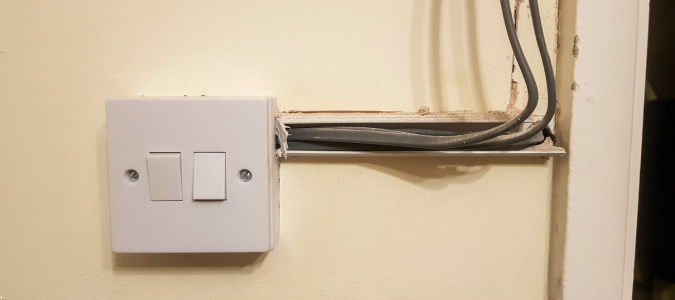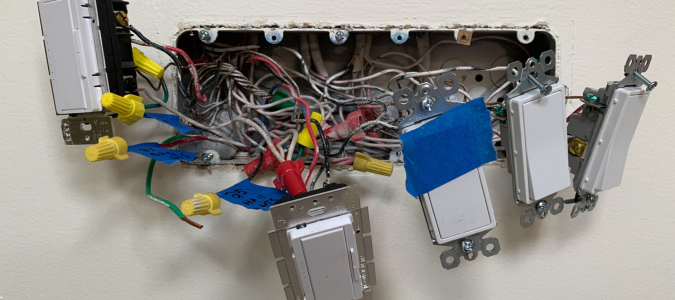When renovating, many homeowners focus on improving the home’s aesthetic appeal. They could add a fresh coat of paint, upgrade appliances or replace old furniture. But what about the wires behind the walls? These might be due for a change, too.
Rewiring a home’s electrical system can help ensure that your family is protected from electrical mishaps, especially if you have an older home. A whole-house rewire involves replacing all of the old wiring throughout your home and installing a new fuse box.
Home rewiring is a highly complicated task and should not be attempted as a DIY project. That’s why you should ask a licensed electrician to handle this task.
How Do Electricians Rewire a Whole House?
A professional electrician follows six key steps when rewiring a house, which include the following:
- Electrical system assessment
- Layout planning
- Outlet and fixture marking
- Old wiring removal
- New wiring installation
- System testing
Let’s break down each of them so you will know what to expect during the process.
Electrical System Assessment
When you ask an electrician to rewire your home, they will first assess your current wiring system. This is a crucial step because it helps the electrician determine whether to replace electrical components or do a full rewiring. Evaluating your electrical system also helps them plan the new wiring layout.
During the assessment, the electrician will:
- Check for outdated wiring that violates the National Electrical Code (NEC).
- Confirm whether the current electrical panel can meet your home’s power demands.
- Test outlets and switches to find faults that may warrant a full home rewire.
- Check for any fire hazards, like exposed wires or faulty circuits.
The electrician will also ask questions about your appliance usage. When they do, let them know if you have any plans to buy a major appliance. That way, the electrician can determine the appropriate size of the electric panel for your home.
Layout Planning
Next, the electrician will determine how many wires, outlets and switches to place and the appropriate locations. The electrician will also choose the best type of wire to use.
A typical layout plan includes the following:
- A room-by-room wiring plan
- Load calculations for each circuit
- Lighting design and smart home features
- Dedicated circuits for major appliances, such as refrigerators and HVAC systems
- Extra outlets
Outlet and Fixture Marking
After the plan is approved, the electrician marks the designated areas for wiring, outlets and fixtures on your walls and ceilings. This step prevents mistakes during installation and ensures everything lines up with the approved plan.
Old Wiring Removal
Before installing new wiring, the electrician must remove the old one. Depending on how your home was originally wired, this process can be straightforward or more complicated.
Either way, the electrician will follow these steps:
- Cut off the power supply to the entire house
- Access wires behind walls, underneath floors and in ceilings
- Remove old wiring and dispose of it properly
Old wiring removal involves accessing hard-to-reach areas by cutting into walls and lifting floorboards. So, expect some dust. However, a professional electrician will be careful to avoid unnecessary damage. That’s why you should only hire a licensed electrician with experience in home rewiring.
New Wiring Installation
Once the old wiring is out of the way, the electrician installs the new one.
Here’s what the electrician will do at this stage:
- Run new wires through the path they mapped out
- Install circuit breakers
- Install ground fault circuit interrupter (GFCI) outlets in the kitchen, bathrooms and laundry room
The National Electrical Code (NEC) mandates GFCI protection for any area of your home where water can reach an electrical appliance.
System Testing
After installing new wiring, the electrician will check the system to ensure everything is working as intended.
Here are the steps the electrical contractor will take at this final stage:
- Verify whether each outlet, circuit, switch and light fixture is working.
- Check for grounding and polarity issues.
- Simulate a fault to check if the GFCI outlets will trip as intended.
- Label the circuit breakers so you know which one controls which part of your room.
How Do You Tell If Your House Needs to Be Rewired?
There are obvious signs that let you know it’s time to contact an electrician for a full home rewiring. Some of these include:
- Flickering or dimming lights
- Frequent circuit breaker trips
- Discolored or sparking electrical outlets
- Burning smell
- Your house was built before 1980
Let’s explore these in more detail.
Flickering or Dimming Lights
A flickering or dimming light is usually the first sign that something’s wrong with your home’s electrical system. Sometimes, it could be a minor annoyance that can be fixed by simply tightening a loose bulb or replacing a faulty switch. Other times, it may point to a more serious problem that needs professional attention.
Here are three possible triggers to keep in mind:
- Lights flicker when you have loose wires, which can interrupt the power supply to your home.
- Lights dim when your electrical system can’t keep up with large appliances, like an HVAC unit.
- Either of these signs could indicate an overloaded circuit, which means too many devices are sharing the same power line.
If these issues keep happening, especially in multiple rooms, ask an experienced electrician to inspect your home.
Frequent Circuit Breaker Trips
A circuit breaker is a safety device in the electrical panel that shuts off power to a circuit if an issue occurs.
You could be dealing with:
- An overloaded circuit
- An overcurrent
- A short circuit
- A faulty appliance
These are all simple issues that a licensed electrician can fix. But if the circuit breakers keep tripping, and you’ve ruled out or fixed possible triggers, it means you’re dealing with a more serious problem, like outdated home wiring. Schedule an electrical inspection with a professional.
Discolored or Sparking Electrical Outlets
According to the National Fire Protection Association, electrical failures in homes cause approximately 46,700 house fires each year. Most of the time, a small spark in an outlet is the first sign you’ll notice.
Sparking outlets are easy to spot. Besides visible sparks, here are other signs to watch out for:
- The outlet smells like burning
- The cover plate shows a brown, yellow or black discoloration
- The cover plate feels hot when you touch it
- You hear a popping or cracking sound when you turn on the outlet
Keep in mind, though, that a sparking outlet can indicate a minor issue, like a momentary arc when plugging in a device. But, if the spark is large, lasts more than a second or is accompanied by any of the above signs, stop using the outlet and call in an electrician.
Burning Smell
If the area around your outlets or switches smells like burning, don’t wait it out. This could mean that the electrical wiring is overheating or outdated.
If you believe there is a fire or if you see fire, call the fire department immediately.
To protect your home from a fire hazard, here are some simple steps you should take:
- Shut off the power to the affected area if you perceive a burning smell in one area.
- If the smell is around the breaker box, cut off power to the entire home.
- Unplug all appliances in the affected areas.
- Call in a licensed electrician to check your electrical system.
Your House Was Built Before 1980
Older homes often have outdated wiring. If your home was built before 1980 and has never been rewired, there’s a good chance it uses aluminum wiring. In this case, don’t wait for visible signs of damage before scheduling a full house rewire.
Aluminum is an inexpensive wiring material, but it’s prone to overheating and corrosion, increasing the chances of an electrical failure. If your home uses aluminum wiring, you may have experienced a GFCI outlet that did not reset or an outlet that stopped working, but the breaker was not tripped.
Due to these safety concerns, homeowners are switching to copper wiring. While copper is more expensive, it’s a better option because of its durability and how well it conducts electricity.
Call in a Licensed Electrician to Fix Old Wiring
Remodeling your home isn’t just about improving its aesthetics. It is also about keeping your home safe and making it more efficient for modern living. And that sometimes means upgrading the electrical system. Sometimes, it shows obvious warning signs, like a faulty circuit breaker or a burning smell. Other times, it silently breaks down.
You don’t have to wait until the wiring develops a fault before protecting your home. If your home is more than 45 years old, it’s time to upgrade the electrical system. Contact an experienced electrician for an electrical system assessment.
ABC Can Help With Your Electrical Needs
Have you been experiencing issues with your circuit breaker, outlets or another electrical component of your home? If so, contact the licensed electricians at ABC Home & Commercial Services. We offer a variety of electrical services, including panel upgrades.



